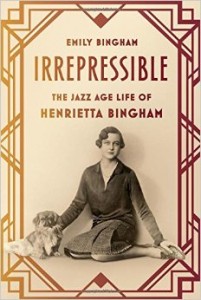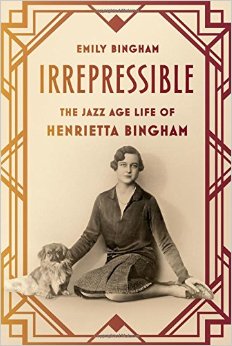 Irrepressible: The Jazz Age Life of Henrietta Bingham
Irrepressible: The Jazz Age Life of Henrietta Bingham
by Emily Bingham
Farrar, Straus and Giroux. 385 pages, $28.
AN OLD TRUNK, a cache of letters, and revelations about the life of a great aunt whose secret was buried by her family for decades provide the backdrop for Emily Bingham’s biography of Henrietta Bingham (1901-1968). She was the daughter of Robert Worth Bingham and Eleanor Miller Bingham. Her father was a well-known Kentucky newspaper publisher and politician. He was made American ambassador to the Court of St. James from 1933 to 1937. When she was twelve, while en route with her mother to her grandmother’s country house, there was an accident at a railway crossing and her mother was killed. According to Emily Bingham, the family never recovered from the loss. The father became very dependent on his daughter and exerted an undue influence on Henrietta that at times might be classified as emotionally incestuous.
All of this is back story to the main narrative, which is Henrietta’s big secret: that she was bisexual and lesbian during the course of her life. The book examines her complicated and often conflicted feelings about her sexuality. Her first affair was with her professor at Smith College, Mina Kirstein (sister of Lincoln Kirstein, co-founder of the New York City Ballet). Mina exerted an enormous influence on Henrietta, convincing her to go to England to undertake psychoanalysis with Ernest Jones (Sigmund Freud’s official biographer). So began her lifelong attempt to “straighten” herself out.
Despite all the hours on the psychoanalytic couch when she would be told that her sexuality was “immature” and needed to develop into a healthy, adult heterosexuality, Henrietta managed to carve out quite an amazing roster of lesbian and bisexual friends and lovers: Mina Kirstein; the actors Peggy Lehmann, Tallulah Bankhead, Hope Williams, and Katherine Cornell; members of the Bloomsbury literary crowd, Dora Carrington, John Houseman (actor, collaborator with Orson Welles, author of The Cradle Will Rock); and the tennis player Helen Jacobs.
Irrepressible details Henrietta’s “wild” life in the 1920’s and 1930’s—the endless parties, travels, and psychoanalysis. All this changed in 1937 when her father died and she lost a major emotional and financial supporter. Subsequently she became increasingly depressed and alcoholic and suffered the first of many nervous breakdowns. In 1948, her condition was so severe that a lobotomy was recommended by her physician, but it was not carried out. She underwent electroshock therapy for the depression, but her condition continued to worsen until her death in 1968.
Raised in a world of wealth and privilege, Henrietta’s unfortunate decline can be traced to the sexist and homophobic attitudes of the times. Her world was pre-Stonewall—gays and lesbians were seen as sick and in need of “conversion” to normalcy. Her experiences in psychoanalysis further reinforced her self-hatred. Unfortunately, she died a year before Stonewall and too early to benefit from the effects of the Women’s Movement. And she paid dearly for having openly lesbian relationships, losing countless family members and friends due to her “unspeakable secret.” Her great niece Emily Bingham has written a biography that has brought her great aunt out of the shadows and into the light; in so doing, another lesbian’s lost story has been brought back into the annals of “herstory.”
_____________________________________________________
Irene Javors is a psychotherapist in New York City.






